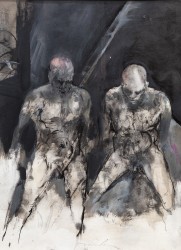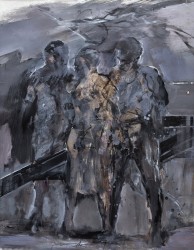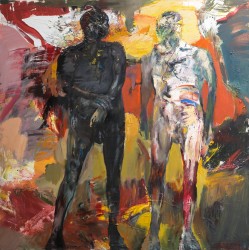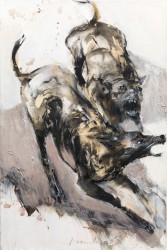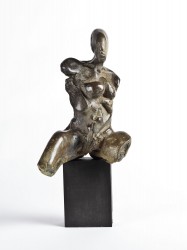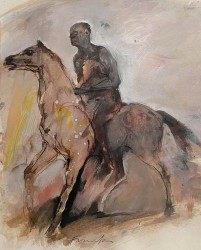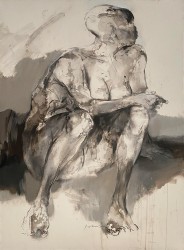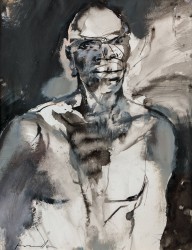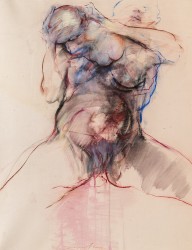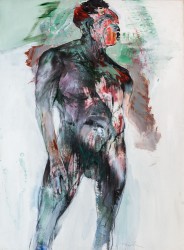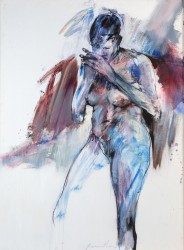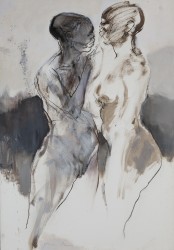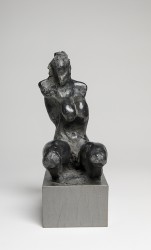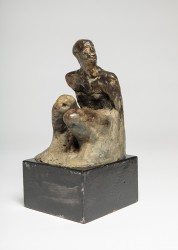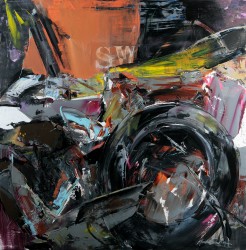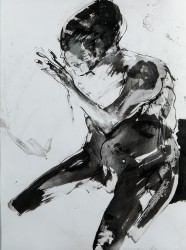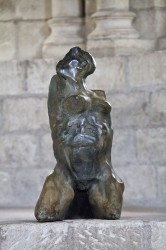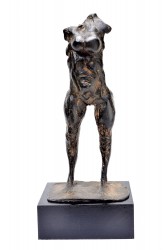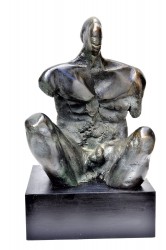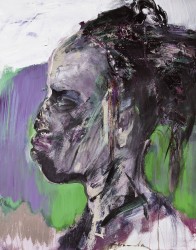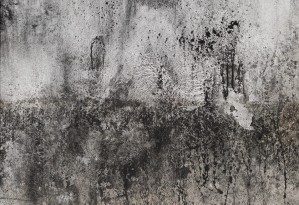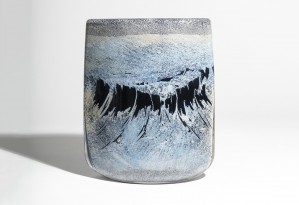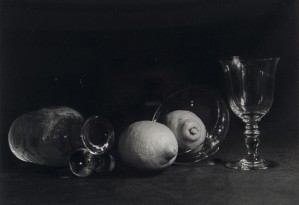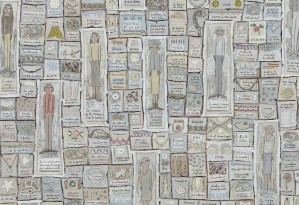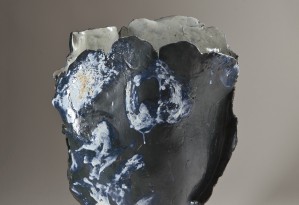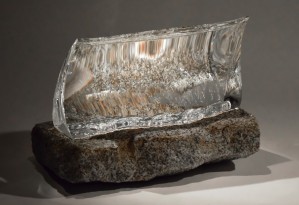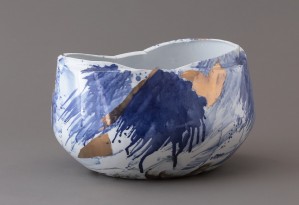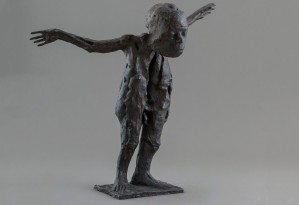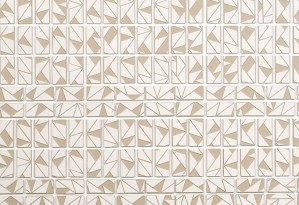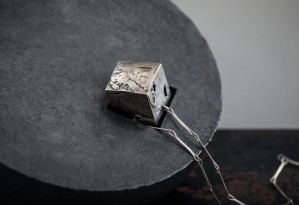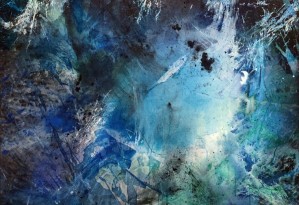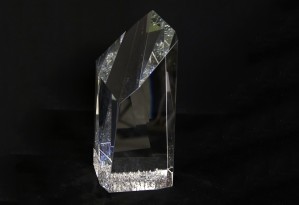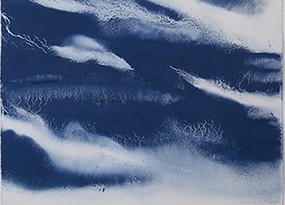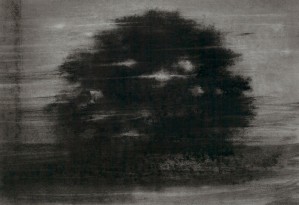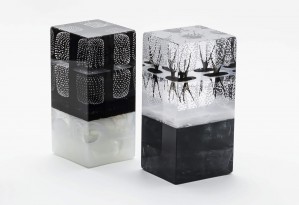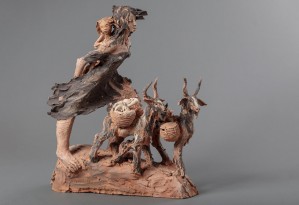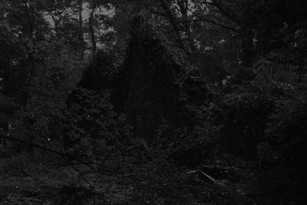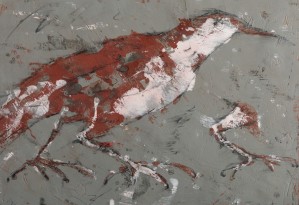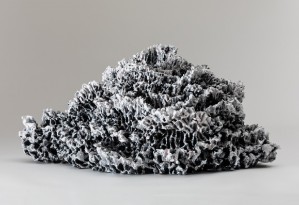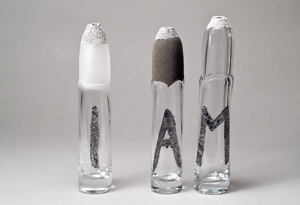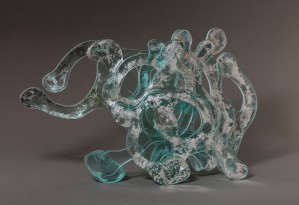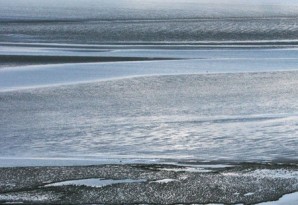FRANTA, painting, sculpture, Permanent artist of Galerie Capazza since 1992
“For what the object demands of me is not to be “understood” but felt. Being in front of this painting is like listening to a Bach fugue: the representation makes way for the expression. I keep coming back to those large spurts of colour that mark a new degree to franta’s expressionistic strength. There is no doubt in my mind that it was through passionate questioning of his painting in progress that he arrived at the sterile, golden space (material comfort, clear conscience, the wealth of the media, and so on) that towers arrogantly over the composition and stands in absolute contrast with the rest. His neighbour, Marc Chagall, whose garden he could see from his own, used to tell him that to make a painting you had to suffer. Franta did not need this lesson, for the origin of the aesthetic depth in his painting has always been in his power to express his subjectivity, which he can only do after much evidently painful effort. As for the questions, they will receive no more answer than Gaugin’s (“Where do we come from? Where are we going?”). Great artists always ask the same questions, just more strongly than ordinary mortals, and this is enough, for it rouses others from their numbness.
Just at there are superficial men, there are superficial works that seem literally superfluous, incapable of justifying their own existence (Schopenhauer would say: incapable of displaying the will that promotes them to being). They have no interiority because they contain nothing that suggests an internal necessity. Whereas every painting, drawing, wash-drawing, or sculpture of Franta’s seems shored up by an irrepressible international necessity. They contain awareness, and this awareness is deep due to their inner life. The relationship from self to self is then expressed in the dialectic of the reflected and the reflecting. This depth is externalized by a fundamental relationship to a world, if it is indeed true that awareness is at once related to the self and to a world. Let us say that, with Franta the relationship to the self conditions the relationship to the world, while being in the world awakens self-awareness. Thus we come closer to the depth of the aesthetic object in Franta’s work, which has the property of asserting itself as object, but also of subjectifying itself as a source of a world.
In front of a painting by Franta, I respond to a double call: it solicits both reflection, because it coherency justifies an objective knowledge, and feeling, for it does not wear itself thin with this knowledge and it provokes an emotion. He has of course only achieved his expressive subjectivity through the rigour and steadiness of his goal. We will not know “in whose name” nor “in the name of what” the unacceptable is wrought. But it is certainly thanks to artists like Franta asking the question more forcefully that we experience not hatred in the faceof this evi world but an ontological sensation. Through his art, the unacceptable invites us to revive the meaning of beings and their existence. Franta’s pictorial work thus inscribes itself within the legacy of the most lucid thinkers of his time, starting with Albert Camus.
“The aim of this essay”, wrote Albert Camus at the beginning of The Rebel: An Essay on Man in Revolt, “is to accept the reality of the moment that is the logical crime and specifically examine the justifications for it… An era which in the space of fifty years uproots, enslaves and kills close to seventy million individuals must be judged.” The agnostic Camus demonstrates that nihilism leads to murder. “Irrational and rational crimes also betray the
value brought to light by the movement of revolt. He who denies everything authorizes himself to kill.” Refusal of the unacceptable is also refusal of nihilism: fait in art vis necessarily faith in man. A capacity to produce beauty helps men to think that an infinitely good being does exist. Beyond all reasons for despair, from the camps to 11 September 2001, the actual works that evoke them bring us -because they are art- closer to God. I do not know if this is Franta’s intention, but the fact is there: his art, which for the most part draws its inspiration from the world’s misfortune, brings us an inestimable effect of beauty. The world that is revealed by the aesthetic object he creates, Franta sheds light on the real world and ourselves, and we realize that we needed this light. Like the poet in Terezin, from the depths of the night Franta will have witnessed the splendour of day”.
Extract from "From the Depths of the Night, Witness the Splendour of the Day" by Jean-Luc Chalumeau, translated by Gail de Courcy-Ireland
Biography
Franta was born in 1930 in Trebic, Moravia, Czechoslovakia. His father left Czechoslovakia to fight Hitler’s troops in France, and then went into the English army. His mother stayed behind with her two sons, and was arrested by the Gestapo.
Franta dreamed of becoming a racing cyclist. His first paintings were inspired by track cyclists.
From 1948 to 1952 Franta studied at the school of decorative arts in Brno, then from 1952-1958 continued his studies at the Academy of Fine Arts in Prague. In 1956 a study trip to the Academia delle Belle Arti de Perugia in Italy paved the way for his first contact with contemporary art, but also the works of Giotto, Mantegna and Masaccio, among anothers.
There he met Jacqueline, his future wife.
He made up his mind to leave Czechloslovakia and smuggled himself into the West across the East Berlin border. He stayed in refugee camps before reaching France, where he met up with Jacqueline and married her.
He stared to work in painting and sculpture in Nice, where he settled.
In a highly unfavourable context for figuration, his work was strongly marked by expressionism and neo-realism.
He has travelled frequently to black Africa (Kenya, Mali, Burkina Faso, Senegal, Gambia), the USA, Denmark, Holland, Japan, India, England, Spain, Mexico, Germany, Portugal, Greece and Turkey.
Read morePublic collections
France
Fonds Nationaux de l'Etat, Paris
Musée d'Art Moderne de la Ville de Paris, Paris
Bibliothèque Nationale, Paris
La Villette -Cité des Sciences et de l'Industrie, Paris
Centre National d'Art Contemporain, Paris
Musée de Peinture, Grenoble
Collection de la Ville, Grenoble
Fondation Maeght, Saint-Paul de Vence
Fonds Régional pour l'Art Contemporain, Marseille
Musée Cantini, Marseille
Fondation Van Gogh, Arles
Fonds Régional pour l'Art Contemporain, Strasbourg
Musée d' 'Art Contemporain, Dunkerque
Fonds Régional pour l'Art Contemporain, Reims
Musée Chéret, Nice
Musée de la Castre, Cannes
Musée d'Art Moderne, Lyon
Maison de la Culture, Grenoble
Musée Picasso, Antibes
Musée de la Ville, Toulon
Musée Départemental, Epinal
Musée de la Ville, Menton
Château-Musée, Cagnes sur Mer
Musée d'Art Moderne, Baux de Provence
Musée des Arts Graphiques, Roquebrune Cap Martin
Read moreAbroad
Musée Tchèque d'Arts Plastiques, Prague, Czech Republic
Galerie Nationale, Prague, Czech Republic
Zapadomoravske Museum, Trebic, Czech Republic
Musée de Moravie, Brno, Czech Republic
Galerie Vysociny, Jihlava, Czech Republic
Ghetto Museum, Terezin, Czech Republic
Collection pour Lidice, Lidice, Czech Republic
Musée d'Art Contemporain, Skopje, Republic of Macedonia
Musée d'Art Moderne, Slovejn Gradec, Slovenia
Musée d'Art Moderne, Belgrade, Serbia
Musée de la Ville, Sarajevo, Bosnia and Herzegovina
Musée d'Art Moderne, Ljubljana, Slovenia
Fondation Veranneman, Kruishouten, Belgium
Museo d'Arte Moderno, Castelanza, Italia
Fondazionne Pagani, Legnano, Italia
Antonie Deussen Stiftung, Zurzach, Switzerland
Kunst Museum, Düsseldorf, Germany
Kunst Museum, Bochum, Germany
B.Russel Foundation, Londres, Great Britain
The Guggenheim Museum, New York, USA
Bronx Museum of the Arts, New York, USA
Coca Cola Bottling Co, New York, USA
Brooklyn Museum, New York, USA
The Haggerty Museum of Art, Milwauke, USA
Collection Hasegawa, Tokyo, Japan
Musée d'Art Contemporain, Nagoya, Japan
Israel Museum, Jerusalem, Israël
Mourtala Diop Collection, Dakar, Senegal
Collective exhibitions - Art Fairs (since 2015)
2021 Enfances, Galerie Capazza, Nançay
2020 Le torse d’une femme à la pureté d’un vase, grands courbes simples d’un fruit désiré, Parcours d’art contemporain autour d’Auguste Rodin, 1 exhibition, 5 locations, Galerie Capazza, Nançay
2019 L’arbre c’est le temps rendu visible, Galerie Capazza, Nançay
Antica Namur 2019 – November 9th to 17th, Hall 1 stand D19, avec la Galerie Capazza, Belgique
2018 Miroir des Sentiments, Galerie Capazza, Nançay
2017 Il est grand temps de rallumer les étoiles, Galerie Capazza, Nançay
2016 Vénus et Vulcain, Galerie Capazza, Nançay
2015 Ensemble depuis 40ans, Galerie Capazza, Nançay
Read morePersonal exhibitions
2018 "D'homme à hommes", in partenership with Galerie Capazza (Nançay) and the Department Council of Indre-et-Loire, Prieuré St Cosme, La Riche
2016 Personal exhibition, Galerie Capazza, Nançay
2015 Ostrava, Galerie des Beaux-Arts
2013 Coustellet, Galerie 22
Saint Paul de Vence, Galerie Bogena
Mol, Art Point International
2012 Prague, Musée Kampa
Prague, Nova Sin
2011 Galerie Capazza, Nançay
Centre d'Art Contemporain, Eysines
Galerie Art 204, Düsseldorf
Galerie Marie Pierre Vitoux, Paris
2010 BARGEMON Galerie Beddington Fine Arts, Bargemon
Art Point Gallery International, Mol
Clos des Cimaises, St Geroges du Bois
2009 Galerie Bogena, Saint Paul de Vence
Egon Schiele Art Centrum, Cesky Krumlov
Musée de la Ville-Château Spilberk, Brno
Galerie de Saint James, Bordeaux-Bouliac
2008 Galerie Françoise Souchaud, Lyon
Espace Paul Riquet, Beziers
Galerie Marie Vitoux, Paris
Maison des Artistes, Haute de Cagnes
2007 Galerie P.M. Vitoux, Paris
Espace Sévigné, Paris
Chapelle des Ursulines, Quimperlé
Chapelle de l'Observance, Draguignan
2006 Galerie Capazza, Nançay
Galerie Ardital, Aix-en-Provence
2005 Musée site Buffon, Montbard
Galerie Art 204, Düsseldorf
Espace Ecureil, Marseille
Galerie Blanche, Falicon
2004 Lycée St Charles, Marseille
Galerie P.M. Vitoux, Paris
2003 Galerie Bogena, Saint-Paul
2001 Espace Ecureuil, Toulouse
Espace St.Jean, Melun
Galerie Terre d'Art, Saint Paul
Vieux Presbytère, Gorbio
2000 Villa Tamaris, La Seyne sur Mer
La Hune Brenner, Paris
Galerie Art 204, Düsseldorf
1999 Ferme des Arts, Vaison la Romaine
B-Art Space, Tokyo
1998 Galerie Art 204, Düsseldorf
Galerie Capazza, Nançay
1997 Espace Écureuil, Marseille
Musée de la Ville, Trebic
Galerie Art 204, Düsseldorf
Galerie Hasegawa, Tokyo
Hasegawa Space Concept Company, Tokyo
1996 Passage de l'Art, Marseille
Château-Musée, Cagnes-sur-Mer
Musée Hébert, Grenoble
Le parcours du regard, Oletta
Maison des Princes, Perouges
1995 Centre Culturel Franco-Nigérien, Niamey
Musée Tchèque d'Arts - Plastiques, Prague
MAMAC SCLOS DE CONTES Lou Peuy, Nice
1993 Galerie Capazza, Nançay
Galerie ART 204, Düsseldorf
1992 Haggerty Museum of Art , Milwaukke
1991 Pernod-Hall J. Hemard, Créteil
Galerie Suzel Berna, Antibes
Galerie Evelyne Canus, La Colle sur Loup
1990 Galerie Eterso, Cannes
Musée de la Castre, Cannes
Galerie Art 204, Düsseldorf
Galerie Pierre Lescot, Paris
1989 Bronx Museum of the Arts, New York
Terry Dintenfass Gallery, New York
Miller's Studio, Zurich
Espace Gavoty, Brignoles
Kunstmuseum, Bochum
Studio Kostel, Paris
1988 Galerie Jade, Colmar
Miller-Brown Gallery, San Francisco
Alliance Française, San Francisco
Lippische Gesselschaft für Kunst, Detmold
1987 Musée Picasso, Antibes
Musée d'Art Contemporain, Dunkerque
Galerie Art 204, Düsseldorf
Clasen Gallery, New York
1986 Galerie Pierre Lescot, Paris
Galerie Chave, Vence
Lo Païs, Draguignan
1985 12 Greene Street Gallery, New York
1984 Galerie Joachim Becker, Cannes
Robert Brown Gallery, Washington DC
Anne Johnson Gallery, Cambridge-MA
1982 Centre d'Action Culturelle, Mâcon
Musée de Peinture, Grenoble
Galerie Murs Ouverts, Vence
Galerie Pierre Lescot, Paris
Galerie le Nez en l'air, Nice
Centre National d'Art Contemporain, Nice
1981 Centre d'Art Contemporain, Montignac
Centre d'Art Contemporain, Rouen
Centre d'Action Culturelle, Montbéliard
1980 Ancien Couvent Royal, Saint Maximin
Galerie Alinea, Toulon
Pavillon de l'ancien hospice, Lille
Galerie Alpha, Bordeaux
1979 Galerie Pierre Lescot, Paris
Centre culturel-Le Parvis, Tarbes
Galerie la Tête de l'Art, Grenoble
1978 Galerie Le Lutrin, Lyon
Galerie Remarque, Trans en Provence
1977 Italie Galerie Pagani Milano
1976 Maison de la Culture, Amiens
Centre culturel P.Picasso, Homecourt
Galerie Lornsenstrasse, Kiel
Galerie Candela, Cannes
1975 Centre culturel Pablo Neruda, Corbeil
1974 Maison de la Culture, Saint Etienne
Musée Galliera -Ville de Paris, Paris
Maison de la Culture, Grenoble
Galerie Rencontre, Paris
1973 Musée de la Ville, Menton
1971 Maison de la Culture, Grasse
1968 Galerie Zunini, Paris
Galerie Thot, Avignon
Galerie Zunini, Paris
Galerie Le soleil dans la tête, Paris
1966 Galerie Plaza, Nice
1964 Galerie Internationale, Nice
1962 Haus am Lützoplatz, Berlin
Galerie Internationale
1961 Galerie Internationale, Nice
St. Martin's Gallery, Londres
1960 Galerie Genet, Paris
Galerie Briffaut, Versailles


